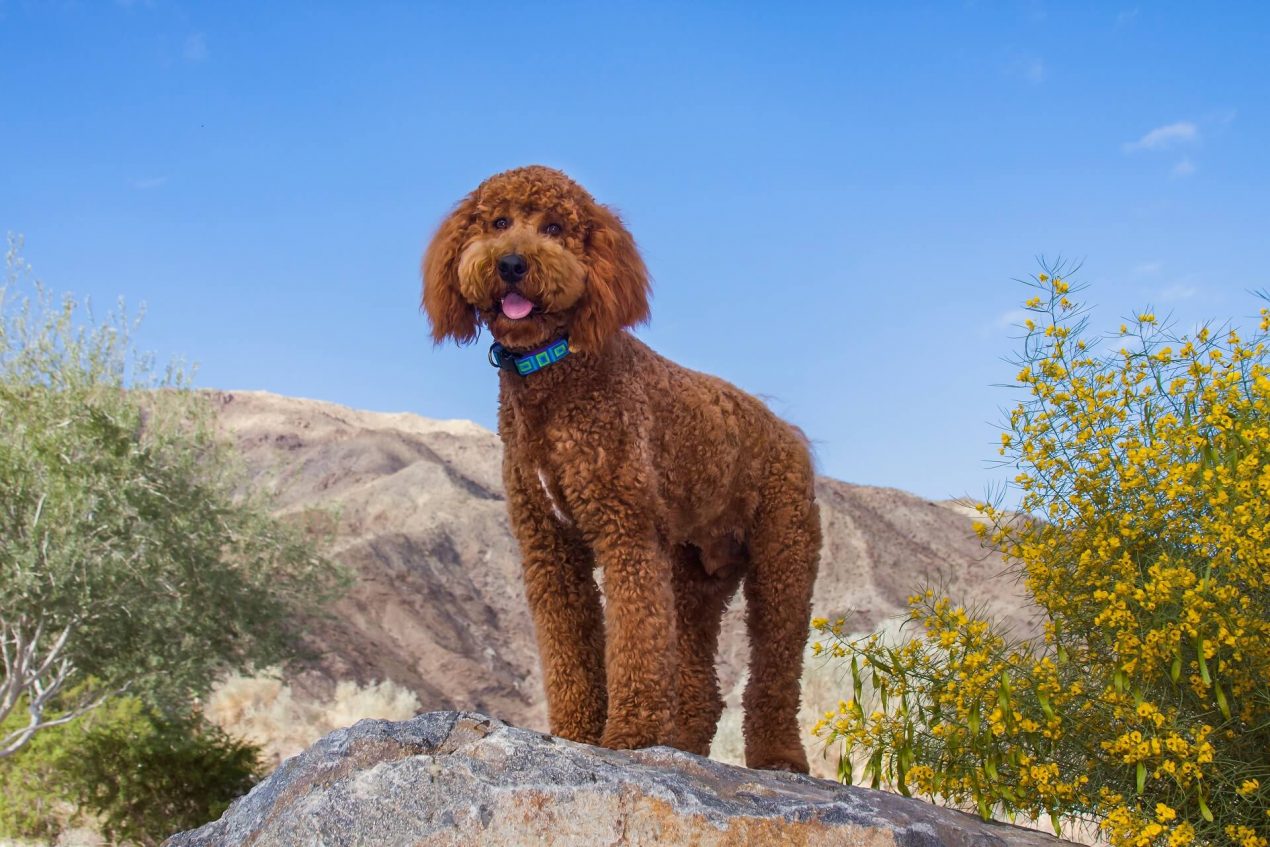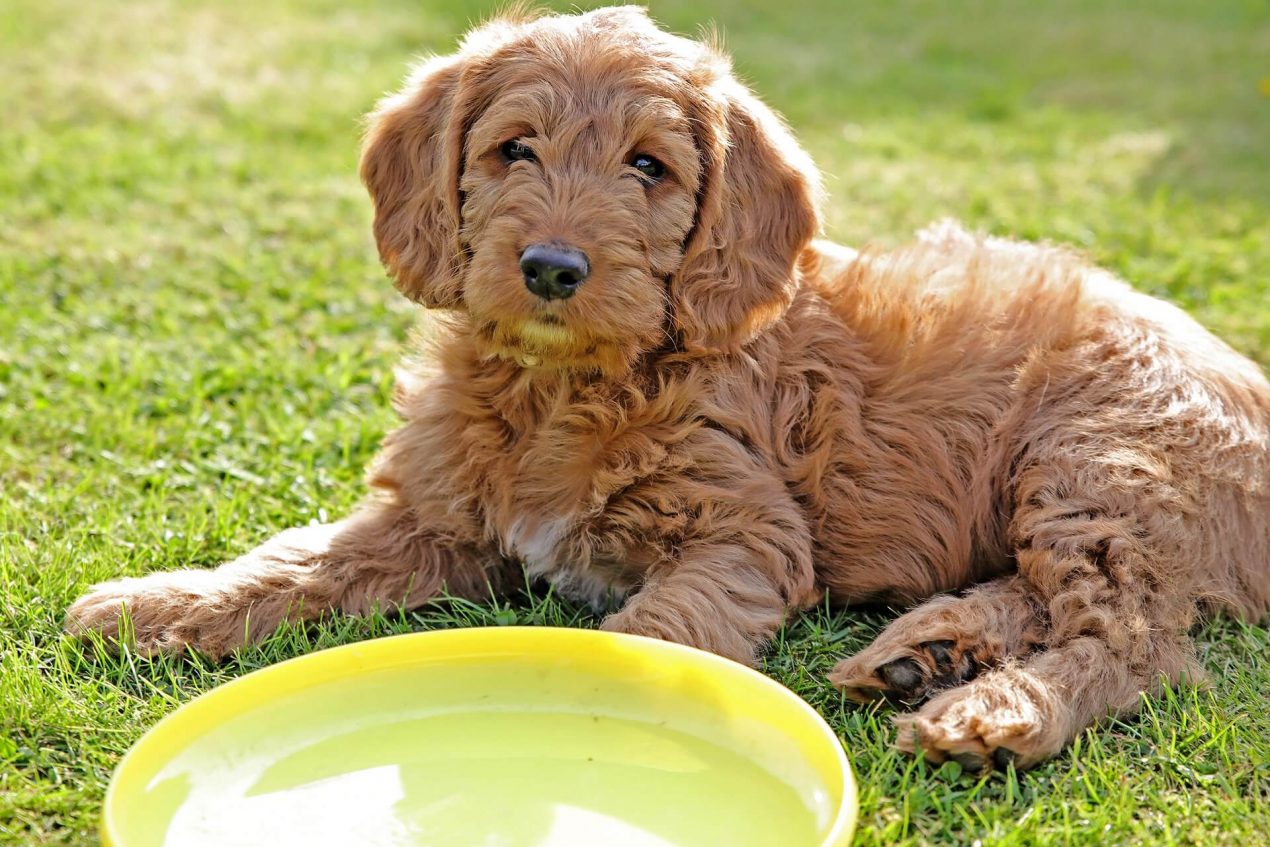The Labradoodle is a young breed and is still not recognized by the FCI. Despite this handicap, the Australian breed is becoming increasingly popular. This cheerful and uncomplicated four-legged friend is the ideal beginner and family dog.
History of the Labradoodle
The history began in 1989 when a woman was looking for a dog for her blind husband. The problem was that her husband was allergic to dog hair. In her desperation, she turned to the “Guide Dog Association of Victoria”. This association was responsible for guide dogs and was based in Melbourne, Australia. There, the problem was recognized, and it was understood that it was not a one-time need.
After extensive considerations, the idea was born: to cross a Labrador with a Poodle. This “product” was named Labradoodle. This hybrid breed was a success and quickly became known outside of Australia. The non-shedding Poodle component allowed allergic dog lovers to have their own dog. This breed has not been recognized by the FCI to this day.
Breed Overview
GROUP: Hybrid
HEIGHT: 22 to 25 inches
WEIGHT: 50 to 75 pounds
COAT: curly, long, medium
COAT COLOR: black, brown / chocolate / liver, cream, gold / yellow, red, white
LIFE SPAN: 12 to 14 years
TEMPERAMENT: friendly, gentle, outgoing, playful, protective, willful
HYPOALLERGENIC: Yes
ORIGIN: Australia
Appearance of the Labradoodle
The Labradoodle is known for its characteristic, versatile appearance, which varies depending on genetic predisposition. This breed is characterized by the following features:
- Coat: The Labradoodle’s coat can vary depending on the genetic line. There are three main coat types: woolly (similar to the Poodle), silky (a mixture of Labrador and Poodle characteristics), and wavy/curly. The coat color ranges from black, white, and brown to gold, cream, and sometimes multicolored.
- Size: Labradoodles come in various sizes, depending on the size of the Poodle parent. There are Miniature (approximately 35-42 cm shoulder height), Medium (approximately 43-52 cm shoulder height), and Standard (approximately 53-63 cm shoulder height) sizes.
- Facial features: They often have the friendly and expressive facial features of a Labrador with the elegant head shape of a Poodle. Their eyes are usually large and expressive, and the ears hang beside the head.
- Body build: Labradoodles typically have a strong, muscular body build, representing a mix of the athletic traits of a Labrador and the elegance of a Poodle.
- Tail: The tail is usually long and can be curly or straight depending on the coat type.
- Grooming: Due to the diversity of the coat, grooming requirements can vary. For example, woolly coats require more frequent brushing and trimming compared to wavy or silky coats.
The appearance of the Labradoodle can vary significantly, with no two Labradoodles looking exactly alike. The variety in coat, color, and size makes each cross unique.
Nature and Character
The Labradoodle’s character is a successful blend of Labrador and Poodle. It combines the best qualities of both breeds. Certainly, the ratio is not 50:50. Some individuals tend more towards the Labrador in their nature, and others towards the Poodle. This combination has produced a friendly and affectionate dog. Due to its intelligence, it is easy to train and can be easily stimulated through playful activities. This breed is the ideal family dog. It is tolerant and accepts other pets (dogs, cats) within the family unit. Its good mood is conveyed daily to its beloved human.

Acquiring a Labradoodle
Before you acquire one, you should decide which Labradoodle suits you best. Your living circumstances and space availability are important factors. This is limited in a house with a garden.
The size of the Labradoodle depends on the genetic makeup of the Poodle. The larger specimens (Standard) usually come from the Standard Poodle. Medium Labradoodles or Mini Labradoodles are accordingly smaller. This does not mean that smaller Poodles are crossed with a Labrador. Labradoodles are bred to be smaller step by step. A Mini Labradoodle is the result of various breeding steps.
Despite the young history of the Labradoodle, there are sad circumstances in this dog’s life. Due to the high life expectancy of up to 15 years, Labradoodles can fall into distress (owner’s death). A Labradoodle in the shelter – unfortunately, this is no longer a rare combination. There, you can find a Labradoodle in black or brown at an adult age and give them a new home.
What should I look for when buying?
Buying a Labradoodle puppy is an absolute matter of trust. It is not a registered breed but a “mixed breed.” Despite this handicap, there are reputable breeders for the Labradoodle. You should definitely consider the following points:
- Personal conversation with the breeder
- Inspection of the parents and puppies in their familiar environment
- Written evidence of veterinary checks
- Evidence of deworming and possible vaccinations
The price of a Labradoodle is $1000 and up.
Development and training of the puppy
A Labradoodle is suitable for novice dog owners. Especially since it wants to please “its owner.” This breed is a cross between a Poodle and a Labrador. In some puppies, the characteristics of one parent are more pronounced. You should definitely take advantage of the help of a puppy or dog school. Some consistency is necessary in training. Beginners often find this difficult with this cute bundle of fur.
Above all, you should practice being alone from the beginning. If neglected, the adult Labradoodle can become a lovable tyrant. Its friendliness towards humans also has a downside. Which person wants to be constantly jumped on by strange dogs (whether big or small)? You can easily address these two points with consistency. You can also find support from other Labradoodle enthusiasts.

How to Care for a Labradoodle
This friendly companion always feels comfortable with its human. Whether it’s an apartment or a house with a garden, it doesn’t matter to them. The confinement of an apartment should be compensated with plenty of exercise and activities. Labradoodle sizes vary. Apartment living is better suited for a smaller “edition.”
Activities with the Labradoodle
A Labradoodle is a lively and spirited dog. Exercise is important and enjoyable for them. They can have a blast romping around with their fellow canines at the dog park. They also have a penchant for dog sports (such as agility, fetching, and tracking). Depending on their size, they may enjoy biking (carefully) and hiking (watch out for their latent hunting instinct). They’re not extreme athletes. Short walks around the block won’t do justice to their energy levels.

Health and Grooming
Labradoodles are generally healthy breeds. Despite this good prognosis, the following diseases may occur during a dog’s lifetime:
- Hip dysplasia (HD)
- Elbow dysplasia (ED)
- Progressive retinal atrophy (PRA) – an eye disease
Particularly sensitive individuals may be prone to skin allergies, bloating, and dental problems. You can counteract these predispositions with a balanced and appropriate diet. This is also useful in the fight against obesity.
Grooming a Labradoodle is a bit more demanding. You should comb or brush your four-legged friend daily. Regular grooming sessions (every 6 to 8 weeks) are practical and give this breed a smart appearance. You can choose the hairstyle according to the type of coat
- Smooth
- Wavy
- Curly
and the season. There is no shedding for summer or winter. Additional care includes checking the ears, claws, and paw pads. Only in emergencies should you bathe them with dog shampoo. Some individuals may have sensitive skin that can be irritated by shampoos.
Interesting Facts
Generally, the Labradoodle is a cross between two dog breeds (Poodle and Labrador). In Australia, the Australian Labradoodle was also created from crosses with six dog breeds. This type of dog was recognized by the Continental Kennel Club (CKC). The price for such a dog is approximately $2500.
The Labradoodle has a reputation for being particularly suitable for allergy sufferers. In part, this is true because this breed hardly sheds. However, you should conduct a test before buying a dog. The trigger for allergic reactions varies for each person.
Do you have a Labradoodle or are you planning to get one? Share with me in the comments what makes them special in your opinion!


